LSBM203 Managerial Finance: Company Financial Analysis and Comparison
VerifiedAdded on 2023/01/17
|22
|4026
|36
Report
AI Summary
This managerial finance report compares the financial positions of Glaxo Smith Kline plc and Reckitt Benckiser Group plc. It calculates and interprets ten financial ratios, including current ratio, quick ratio, net profit margin, gross profit margin, gearing ratio, price-earning ratio, earning per share, return on capital employed, average inventory turnover period, and dividend payout ratio for both companies over two years. The analysis includes graphical representations of the ratios and a performance evaluation to suggest which company is better for investment. The report also provides recommendations for enhancing the performance of both companies based on the financial analysis. Investment appraisal techniques are applied in order to assess the efficiency of the given projects.

MANAGERIAL
FINANCE
FINANCE
Paraphrase This Document
Need a fresh take? Get an instant paraphrase of this document with our AI Paraphraser
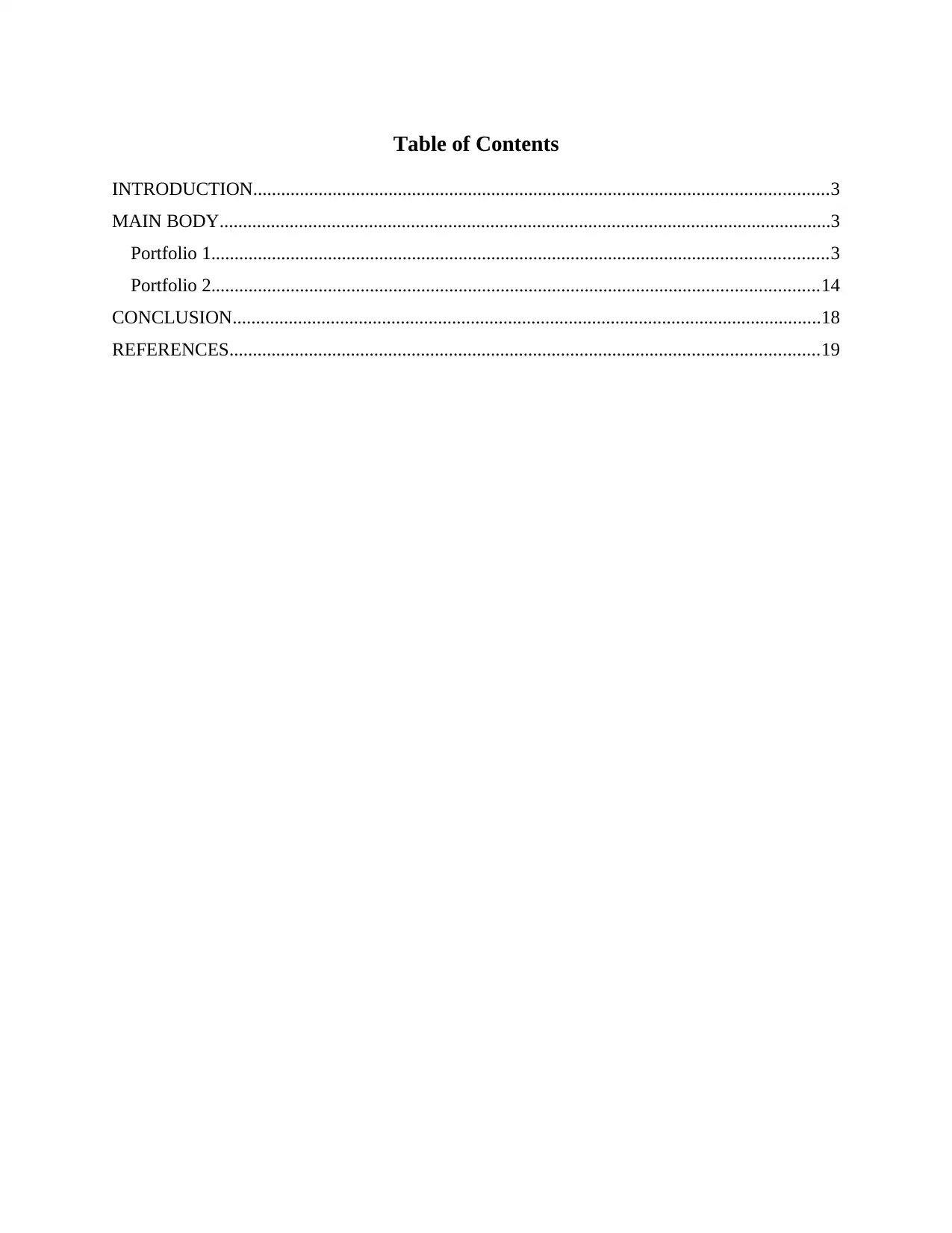
Table of Contents
INTRODUCTION...........................................................................................................................3
MAIN BODY...................................................................................................................................3
Portfolio 1....................................................................................................................................3
Portfolio 2..................................................................................................................................14
CONCLUSION..............................................................................................................................18
REFERENCES..............................................................................................................................19
INTRODUCTION...........................................................................................................................3
MAIN BODY...................................................................................................................................3
Portfolio 1....................................................................................................................................3
Portfolio 2..................................................................................................................................14
CONCLUSION..............................................................................................................................18
REFERENCES..............................................................................................................................19
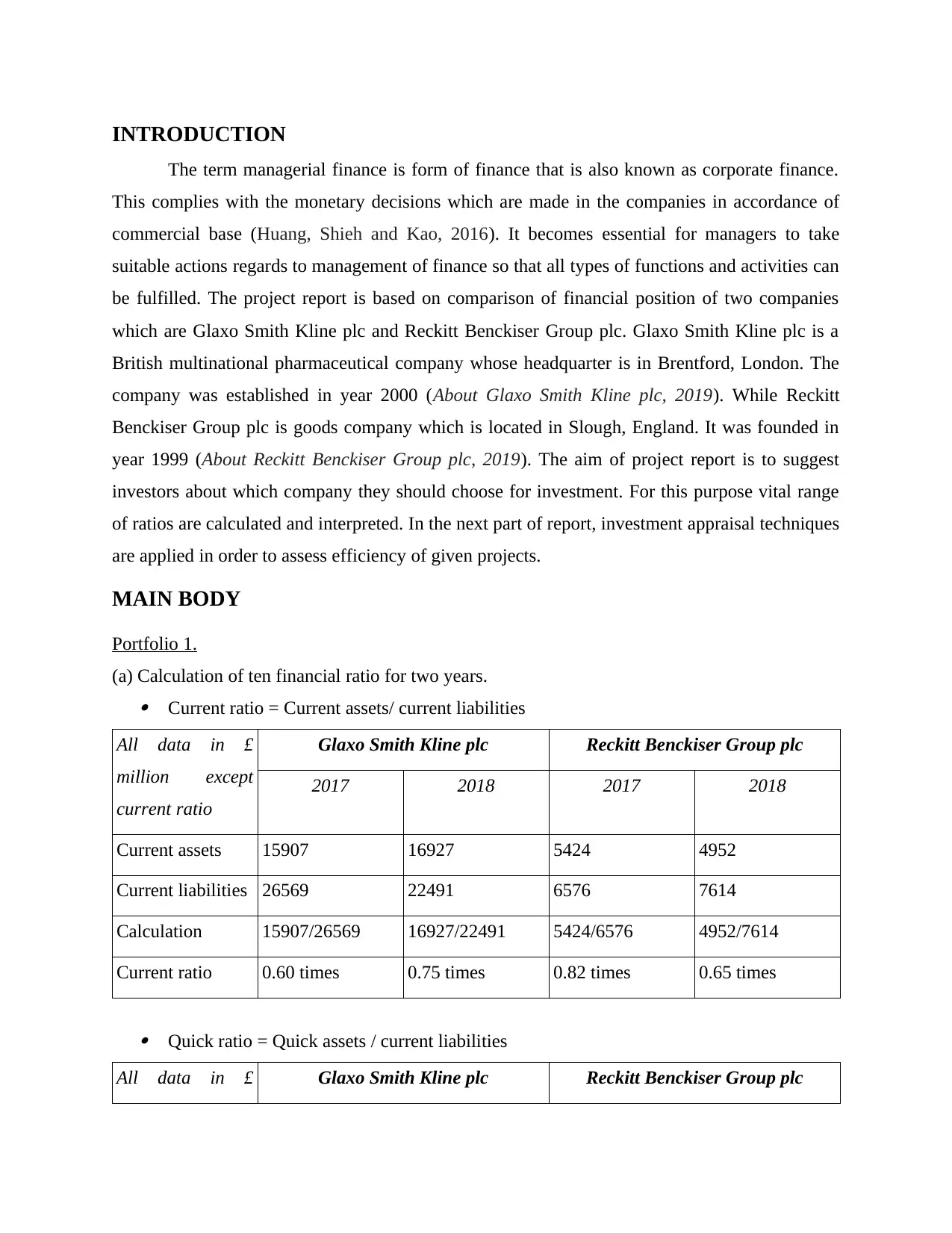
INTRODUCTION
The term managerial finance is form of finance that is also known as corporate finance.
This complies with the monetary decisions which are made in the companies in accordance of
commercial base (Huang, Shieh and Kao, 2016). It becomes essential for managers to take
suitable actions regards to management of finance so that all types of functions and activities can
be fulfilled. The project report is based on comparison of financial position of two companies
which are Glaxo Smith Kline plc and Reckitt Benckiser Group plc. Glaxo Smith Kline plc is a
British multinational pharmaceutical company whose headquarter is in Brentford, London. The
company was established in year 2000 (About Glaxo Smith Kline plc, 2019). While Reckitt
Benckiser Group plc is goods company which is located in Slough, England. It was founded in
year 1999 (About Reckitt Benckiser Group plc, 2019). The aim of project report is to suggest
investors about which company they should choose for investment. For this purpose vital range
of ratios are calculated and interpreted. In the next part of report, investment appraisal techniques
are applied in order to assess efficiency of given projects.
MAIN BODY
Portfolio 1.
(a) Calculation of ten financial ratio for two years. Current ratio = Current assets/ current liabilities
All data in £
million except
current ratio
Glaxo Smith Kline plc Reckitt Benckiser Group plc
2017 2018 2017 2018
Current assets 15907 16927 5424 4952
Current liabilities 26569 22491 6576 7614
Calculation 15907/26569 16927/22491 5424/6576 4952/7614
Current ratio 0.60 times 0.75 times 0.82 times 0.65 times
Quick ratio = Quick assets / current liabilities
All data in £ Glaxo Smith Kline plc Reckitt Benckiser Group plc
The term managerial finance is form of finance that is also known as corporate finance.
This complies with the monetary decisions which are made in the companies in accordance of
commercial base (Huang, Shieh and Kao, 2016). It becomes essential for managers to take
suitable actions regards to management of finance so that all types of functions and activities can
be fulfilled. The project report is based on comparison of financial position of two companies
which are Glaxo Smith Kline plc and Reckitt Benckiser Group plc. Glaxo Smith Kline plc is a
British multinational pharmaceutical company whose headquarter is in Brentford, London. The
company was established in year 2000 (About Glaxo Smith Kline plc, 2019). While Reckitt
Benckiser Group plc is goods company which is located in Slough, England. It was founded in
year 1999 (About Reckitt Benckiser Group plc, 2019). The aim of project report is to suggest
investors about which company they should choose for investment. For this purpose vital range
of ratios are calculated and interpreted. In the next part of report, investment appraisal techniques
are applied in order to assess efficiency of given projects.
MAIN BODY
Portfolio 1.
(a) Calculation of ten financial ratio for two years. Current ratio = Current assets/ current liabilities
All data in £
million except
current ratio
Glaxo Smith Kline plc Reckitt Benckiser Group plc
2017 2018 2017 2018
Current assets 15907 16927 5424 4952
Current liabilities 26569 22491 6576 7614
Calculation 15907/26569 16927/22491 5424/6576 4952/7614
Current ratio 0.60 times 0.75 times 0.82 times 0.65 times
Quick ratio = Quick assets / current liabilities
All data in £ Glaxo Smith Kline plc Reckitt Benckiser Group plc
⊘ This is a preview!⊘
Do you want full access?
Subscribe today to unlock all pages.

Trusted by 1+ million students worldwide
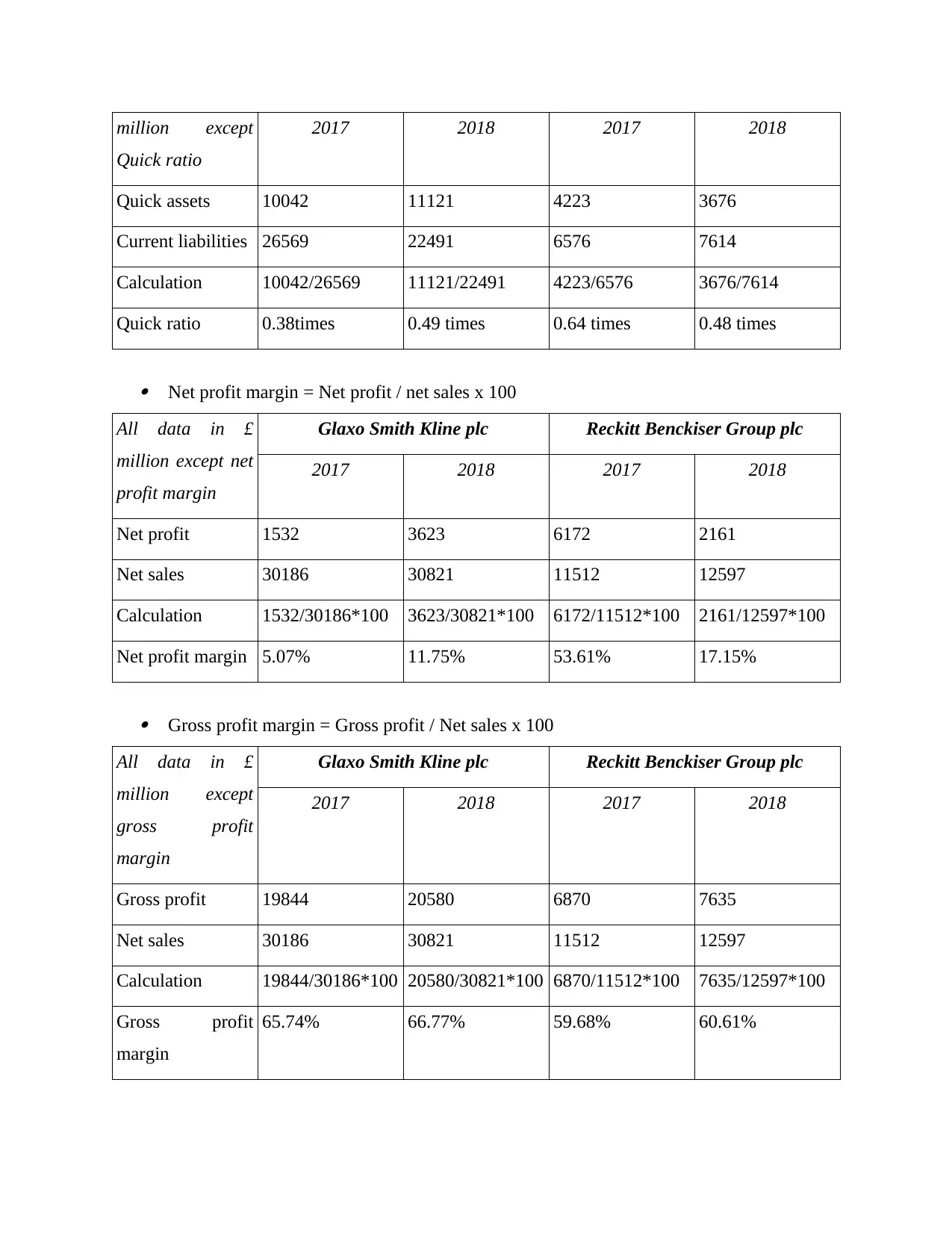
million except
Quick ratio
2017 2018 2017 2018
Quick assets 10042 11121 4223 3676
Current liabilities 26569 22491 6576 7614
Calculation 10042/26569 11121/22491 4223/6576 3676/7614
Quick ratio 0.38times 0.49 times 0.64 times 0.48 times
Net profit margin = Net profit / net sales x 100
All data in £
million except net
profit margin
Glaxo Smith Kline plc Reckitt Benckiser Group plc
2017 2018 2017 2018
Net profit 1532 3623 6172 2161
Net sales 30186 30821 11512 12597
Calculation 1532/30186*100 3623/30821*100 6172/11512*100 2161/12597*100
Net profit margin 5.07% 11.75% 53.61% 17.15%
Gross profit margin = Gross profit / Net sales x 100
All data in £
million except
gross profit
margin
Glaxo Smith Kline plc Reckitt Benckiser Group plc
2017 2018 2017 2018
Gross profit 19844 20580 6870 7635
Net sales 30186 30821 11512 12597
Calculation 19844/30186*100 20580/30821*100 6870/11512*100 7635/12597*100
Gross profit
margin
65.74% 66.77% 59.68% 60.61%
Quick ratio
2017 2018 2017 2018
Quick assets 10042 11121 4223 3676
Current liabilities 26569 22491 6576 7614
Calculation 10042/26569 11121/22491 4223/6576 3676/7614
Quick ratio 0.38times 0.49 times 0.64 times 0.48 times
Net profit margin = Net profit / net sales x 100
All data in £
million except net
profit margin
Glaxo Smith Kline plc Reckitt Benckiser Group plc
2017 2018 2017 2018
Net profit 1532 3623 6172 2161
Net sales 30186 30821 11512 12597
Calculation 1532/30186*100 3623/30821*100 6172/11512*100 2161/12597*100
Net profit margin 5.07% 11.75% 53.61% 17.15%
Gross profit margin = Gross profit / Net sales x 100
All data in £
million except
gross profit
margin
Glaxo Smith Kline plc Reckitt Benckiser Group plc
2017 2018 2017 2018
Gross profit 19844 20580 6870 7635
Net sales 30186 30821 11512 12597
Calculation 19844/30186*100 20580/30821*100 6870/11512*100 7635/12597*100
Gross profit
margin
65.74% 66.77% 59.68% 60.61%
Paraphrase This Document
Need a fresh take? Get an instant paraphrase of this document with our AI Paraphraser

Gearing ratio = Total Debt / Equity
All data in £
million except
Gearing Ratio Glaxo Smith Kline plc Reckitt Benckiser Group plc
2017 2018 2017 2018
Total Debt 56449 53706 23480 22908
Equity -68 4360 13533 14742
Calculation 56449 / -68 53706 / 4360 23480 / 13533 22908 / 14742
Gearing Ratio -830.13 12.32 1.74 1.55
Price earning ratio = Market value per share / earning per share
All data in £
million Glaxo Smith Kline plc Reckitt Benckiser Group plc
2017 2018 2017 2018
Market Price Per
Share 1361 1491.2 6841 5964
Earning Price Per
Share 0.3152 0.7455 8.3859 2.9361
Calculation 1361 / .3152 1491.2 / .7455 6841 / 8.3859 5964 / 2.9361
Price Earning Ratio 4317.89 2000.27 815.77 2031.26
Earning per share = Net Profit / Ordinary Numbers of Shares
All data in £ Glaxo Smith Kline plc Reckitt Benckiser Group plc
2017 2018 2017 2018
Net Profit 1532 3623 6172 2161
Ordinary Numbers 4860 4860 736 736
All data in £
million except
Gearing Ratio Glaxo Smith Kline plc Reckitt Benckiser Group plc
2017 2018 2017 2018
Total Debt 56449 53706 23480 22908
Equity -68 4360 13533 14742
Calculation 56449 / -68 53706 / 4360 23480 / 13533 22908 / 14742
Gearing Ratio -830.13 12.32 1.74 1.55
Price earning ratio = Market value per share / earning per share
All data in £
million Glaxo Smith Kline plc Reckitt Benckiser Group plc
2017 2018 2017 2018
Market Price Per
Share 1361 1491.2 6841 5964
Earning Price Per
Share 0.3152 0.7455 8.3859 2.9361
Calculation 1361 / .3152 1491.2 / .7455 6841 / 8.3859 5964 / 2.9361
Price Earning Ratio 4317.89 2000.27 815.77 2031.26
Earning per share = Net Profit / Ordinary Numbers of Shares
All data in £ Glaxo Smith Kline plc Reckitt Benckiser Group plc
2017 2018 2017 2018
Net Profit 1532 3623 6172 2161
Ordinary Numbers 4860 4860 736 736
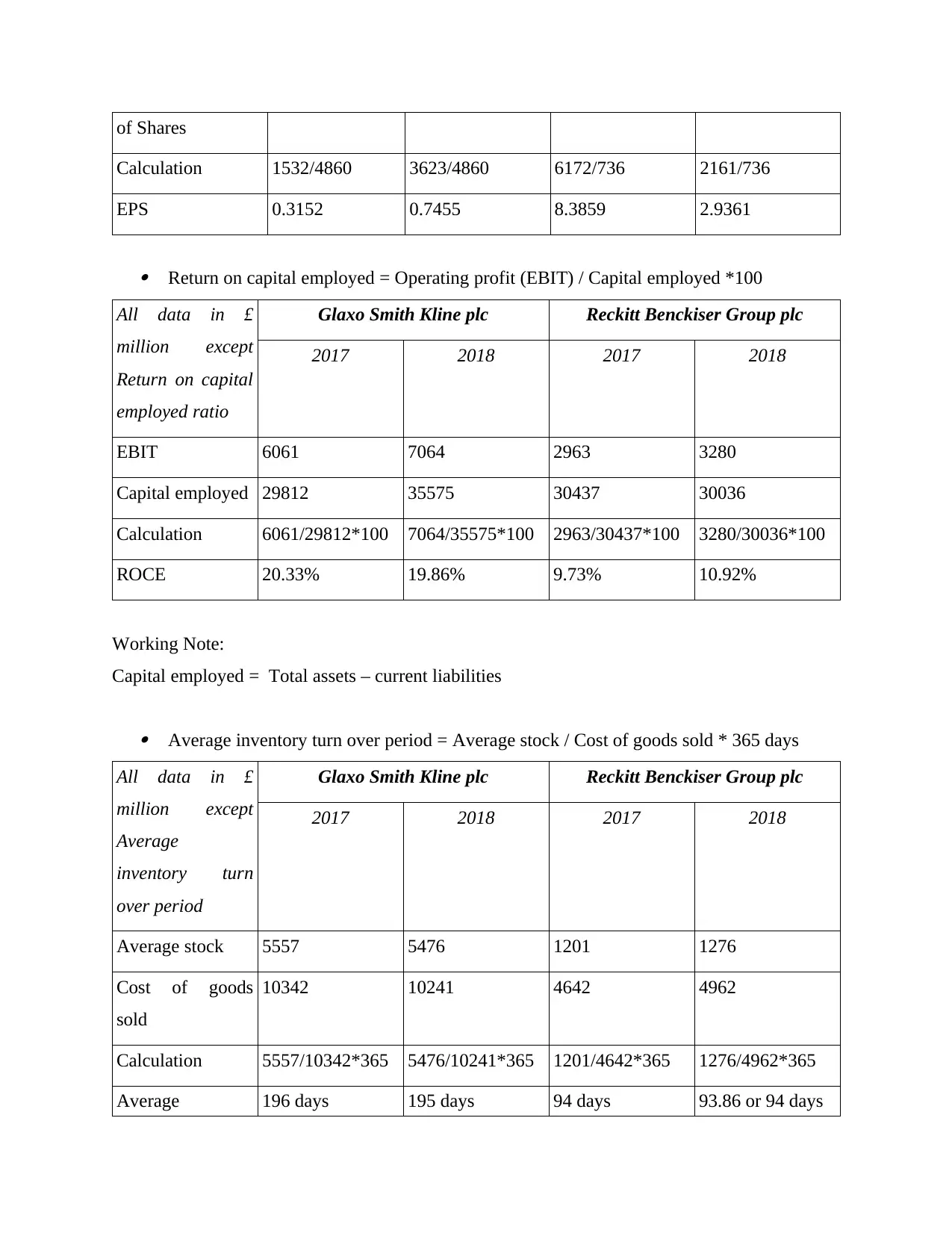
of Shares
Calculation 1532/4860 3623/4860 6172/736 2161/736
EPS 0.3152 0.7455 8.3859 2.9361
Return on capital employed = Operating profit (EBIT) / Capital employed *100
All data in £
million except
Return on capital
employed ratio
Glaxo Smith Kline plc Reckitt Benckiser Group plc
2017 2018 2017 2018
EBIT 6061 7064 2963 3280
Capital employed 29812 35575 30437 30036
Calculation 6061/29812*100 7064/35575*100 2963/30437*100 3280/30036*100
ROCE 20.33% 19.86% 9.73% 10.92%
Working Note:
Capital employed = Total assets – current liabilities
Average inventory turn over period = Average stock / Cost of goods sold * 365 days
All data in £
million except
Average
inventory turn
over period
Glaxo Smith Kline plc Reckitt Benckiser Group plc
2017 2018 2017 2018
Average stock 5557 5476 1201 1276
Cost of goods
sold
10342 10241 4642 4962
Calculation 5557/10342*365 5476/10241*365 1201/4642*365 1276/4962*365
Average 196 days 195 days 94 days 93.86 or 94 days
Calculation 1532/4860 3623/4860 6172/736 2161/736
EPS 0.3152 0.7455 8.3859 2.9361
Return on capital employed = Operating profit (EBIT) / Capital employed *100
All data in £
million except
Return on capital
employed ratio
Glaxo Smith Kline plc Reckitt Benckiser Group plc
2017 2018 2017 2018
EBIT 6061 7064 2963 3280
Capital employed 29812 35575 30437 30036
Calculation 6061/29812*100 7064/35575*100 2963/30437*100 3280/30036*100
ROCE 20.33% 19.86% 9.73% 10.92%
Working Note:
Capital employed = Total assets – current liabilities
Average inventory turn over period = Average stock / Cost of goods sold * 365 days
All data in £
million except
Average
inventory turn
over period
Glaxo Smith Kline plc Reckitt Benckiser Group plc
2017 2018 2017 2018
Average stock 5557 5476 1201 1276
Cost of goods
sold
10342 10241 4642 4962
Calculation 5557/10342*365 5476/10241*365 1201/4642*365 1276/4962*365
Average 196 days 195 days 94 days 93.86 or 94 days
⊘ This is a preview!⊘
Do you want full access?
Subscribe today to unlock all pages.

Trusted by 1+ million students worldwide
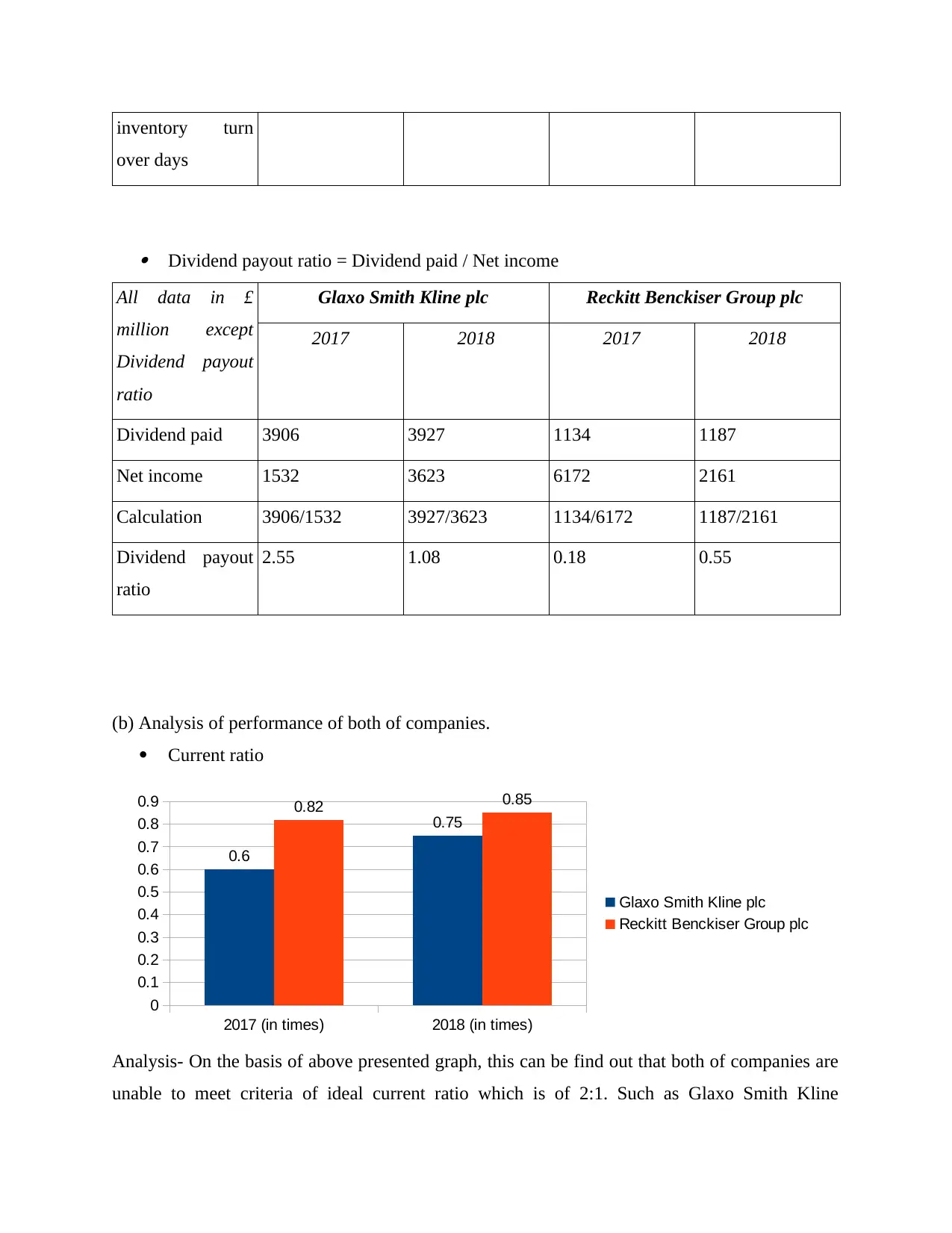
inventory turn
over days
Dividend payout ratio = Dividend paid / Net income
All data in £
million except
Dividend payout
ratio
Glaxo Smith Kline plc Reckitt Benckiser Group plc
2017 2018 2017 2018
Dividend paid 3906 3927 1134 1187
Net income 1532 3623 6172 2161
Calculation 3906/1532 3927/3623 1134/6172 1187/2161
Dividend payout
ratio
2.55 1.08 0.18 0.55
(b) Analysis of performance of both of companies.
Current ratio
Analysis- On the basis of above presented graph, this can be find out that both of companies are
unable to meet criteria of ideal current ratio which is of 2:1. Such as Glaxo Smith Kline
2017 (in times) 2018 (in times)
0
0.1
0.2
0.3
0.4
0.5
0.6
0.7
0.8
0.9
0.6
0.75
0.82 0.85
Glaxo Smith Kline plc
Reckitt Benckiser Group plc
over days
Dividend payout ratio = Dividend paid / Net income
All data in £
million except
Dividend payout
ratio
Glaxo Smith Kline plc Reckitt Benckiser Group plc
2017 2018 2017 2018
Dividend paid 3906 3927 1134 1187
Net income 1532 3623 6172 2161
Calculation 3906/1532 3927/3623 1134/6172 1187/2161
Dividend payout
ratio
2.55 1.08 0.18 0.55
(b) Analysis of performance of both of companies.
Current ratio
Analysis- On the basis of above presented graph, this can be find out that both of companies are
unable to meet criteria of ideal current ratio which is of 2:1. Such as Glaxo Smith Kline
2017 (in times) 2018 (in times)
0
0.1
0.2
0.3
0.4
0.5
0.6
0.7
0.8
0.9
0.6
0.75
0.82 0.85
Glaxo Smith Kline plc
Reckitt Benckiser Group plc
Paraphrase This Document
Need a fresh take? Get an instant paraphrase of this document with our AI Paraphraser
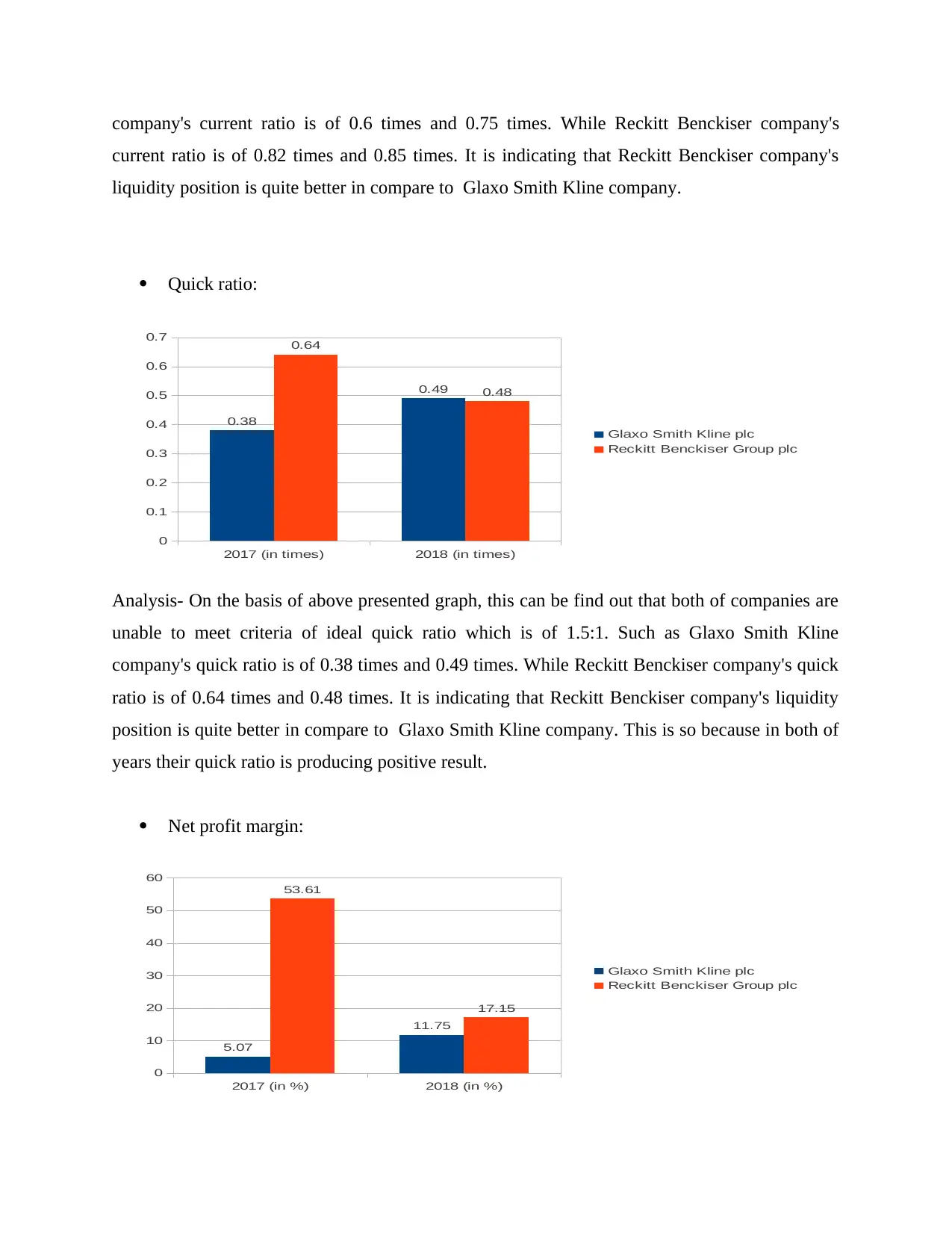
company's current ratio is of 0.6 times and 0.75 times. While Reckitt Benckiser company's
current ratio is of 0.82 times and 0.85 times. It is indicating that Reckitt Benckiser company's
liquidity position is quite better in compare to Glaxo Smith Kline company.
Quick ratio:
2017 (in times) 2018 (in times)
0
0.1
0.2
0.3
0.4
0.5
0.6
0.7
0.38
0.49
0.64
0.48
Glaxo Smith Kline plc
Reckitt Benckiser Group plc
Analysis- On the basis of above presented graph, this can be find out that both of companies are
unable to meet criteria of ideal quick ratio which is of 1.5:1. Such as Glaxo Smith Kline
company's quick ratio is of 0.38 times and 0.49 times. While Reckitt Benckiser company's quick
ratio is of 0.64 times and 0.48 times. It is indicating that Reckitt Benckiser company's liquidity
position is quite better in compare to Glaxo Smith Kline company. This is so because in both of
years their quick ratio is producing positive result.
Net profit margin:
2017 (in %) 2018 (in %)
0
10
20
30
40
50
60
5.07
11.75
53.61
17.15
Glaxo Smith Kline plc
Reckitt Benckiser Group plc
current ratio is of 0.82 times and 0.85 times. It is indicating that Reckitt Benckiser company's
liquidity position is quite better in compare to Glaxo Smith Kline company.
Quick ratio:
2017 (in times) 2018 (in times)
0
0.1
0.2
0.3
0.4
0.5
0.6
0.7
0.38
0.49
0.64
0.48
Glaxo Smith Kline plc
Reckitt Benckiser Group plc
Analysis- On the basis of above presented graph, this can be find out that both of companies are
unable to meet criteria of ideal quick ratio which is of 1.5:1. Such as Glaxo Smith Kline
company's quick ratio is of 0.38 times and 0.49 times. While Reckitt Benckiser company's quick
ratio is of 0.64 times and 0.48 times. It is indicating that Reckitt Benckiser company's liquidity
position is quite better in compare to Glaxo Smith Kline company. This is so because in both of
years their quick ratio is producing positive result.
Net profit margin:
2017 (in %) 2018 (in %)
0
10
20
30
40
50
60
5.07
11.75
53.61
17.15
Glaxo Smith Kline plc
Reckitt Benckiser Group plc
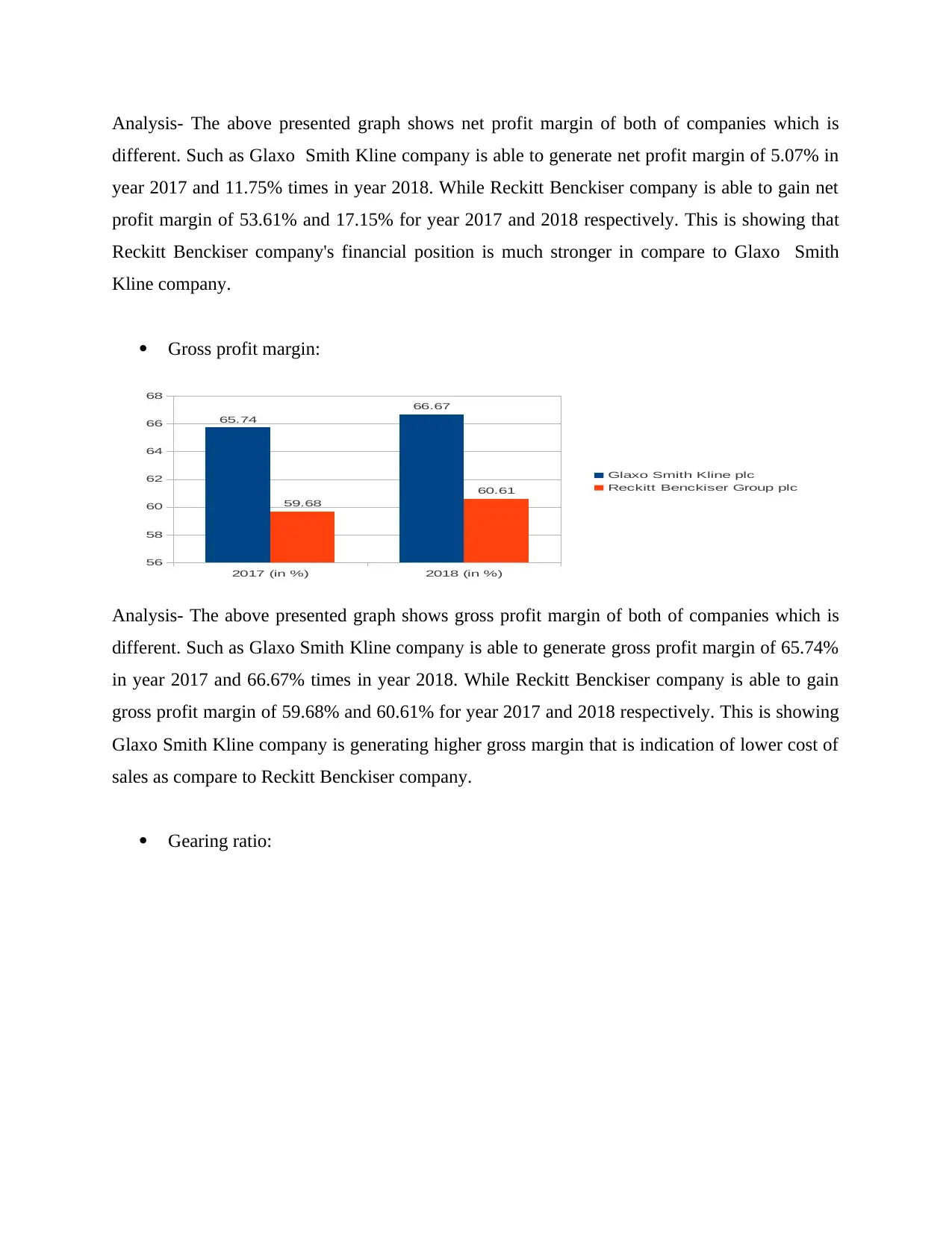
Analysis- The above presented graph shows net profit margin of both of companies which is
different. Such as Glaxo Smith Kline company is able to generate net profit margin of 5.07% in
year 2017 and 11.75% times in year 2018. While Reckitt Benckiser company is able to gain net
profit margin of 53.61% and 17.15% for year 2017 and 2018 respectively. This is showing that
Reckitt Benckiser company's financial position is much stronger in compare to Glaxo Smith
Kline company.
Gross profit margin:
2017 (in %) 2018 (in %)
56
58
60
62
64
66
68
65.74
66.67
59.68
60.61
Glaxo Smith Kline plc
Reckitt Benckiser Group plc
Analysis- The above presented graph shows gross profit margin of both of companies which is
different. Such as Glaxo Smith Kline company is able to generate gross profit margin of 65.74%
in year 2017 and 66.67% times in year 2018. While Reckitt Benckiser company is able to gain
gross profit margin of 59.68% and 60.61% for year 2017 and 2018 respectively. This is showing
Glaxo Smith Kline company is generating higher gross margin that is indication of lower cost of
sales as compare to Reckitt Benckiser company.
Gearing ratio:
different. Such as Glaxo Smith Kline company is able to generate net profit margin of 5.07% in
year 2017 and 11.75% times in year 2018. While Reckitt Benckiser company is able to gain net
profit margin of 53.61% and 17.15% for year 2017 and 2018 respectively. This is showing that
Reckitt Benckiser company's financial position is much stronger in compare to Glaxo Smith
Kline company.
Gross profit margin:
2017 (in %) 2018 (in %)
56
58
60
62
64
66
68
65.74
66.67
59.68
60.61
Glaxo Smith Kline plc
Reckitt Benckiser Group plc
Analysis- The above presented graph shows gross profit margin of both of companies which is
different. Such as Glaxo Smith Kline company is able to generate gross profit margin of 65.74%
in year 2017 and 66.67% times in year 2018. While Reckitt Benckiser company is able to gain
gross profit margin of 59.68% and 60.61% for year 2017 and 2018 respectively. This is showing
Glaxo Smith Kline company is generating higher gross margin that is indication of lower cost of
sales as compare to Reckitt Benckiser company.
Gearing ratio:
⊘ This is a preview!⊘
Do you want full access?
Subscribe today to unlock all pages.

Trusted by 1+ million students worldwide
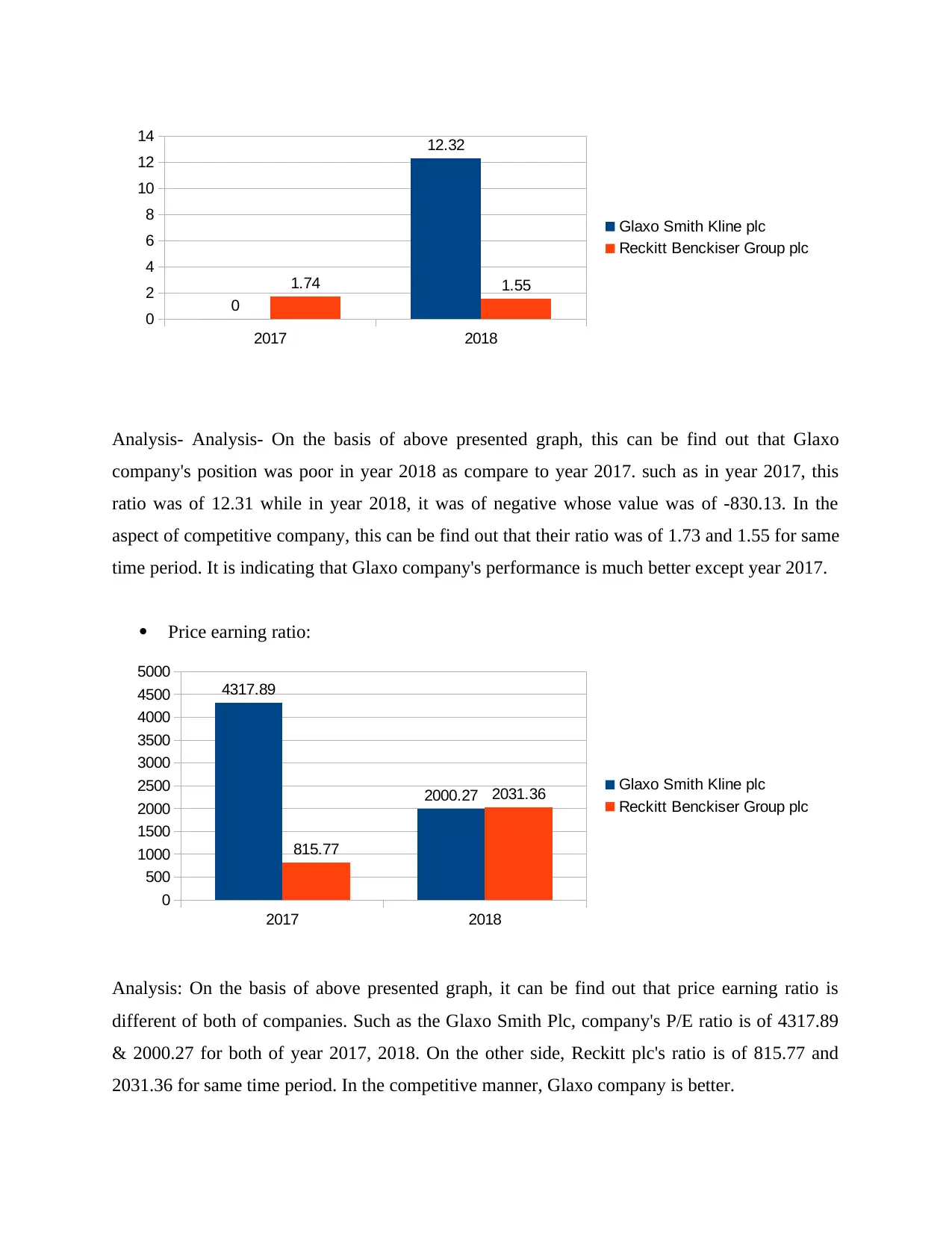
Analysis- Analysis- On the basis of above presented graph, this can be find out that Glaxo
company's position was poor in year 2018 as compare to year 2017. such as in year 2017, this
ratio was of 12.31 while in year 2018, it was of negative whose value was of -830.13. In the
aspect of competitive company, this can be find out that their ratio was of 1.73 and 1.55 for same
time period. It is indicating that Glaxo company's performance is much better except year 2017.
Price earning ratio:
Analysis: On the basis of above presented graph, it can be find out that price earning ratio is
different of both of companies. Such as the Glaxo Smith Plc, company's P/E ratio is of 4317.89
& 2000.27 for both of year 2017, 2018. On the other side, Reckitt plc's ratio is of 815.77 and
2031.36 for same time period. In the competitive manner, Glaxo company is better.
2017 2018
0
500
1000
1500
2000
2500
3000
3500
4000
4500
5000
4317.89
2000.27
815.77
2031.36 Glaxo Smith Kline plc
Reckitt Benckiser Group plc
2017 2018
0
2
4
6
8
10
12
14
0
12.32
1.74 1.55
Glaxo Smith Kline plc
Reckitt Benckiser Group plc
company's position was poor in year 2018 as compare to year 2017. such as in year 2017, this
ratio was of 12.31 while in year 2018, it was of negative whose value was of -830.13. In the
aspect of competitive company, this can be find out that their ratio was of 1.73 and 1.55 for same
time period. It is indicating that Glaxo company's performance is much better except year 2017.
Price earning ratio:
Analysis: On the basis of above presented graph, it can be find out that price earning ratio is
different of both of companies. Such as the Glaxo Smith Plc, company's P/E ratio is of 4317.89
& 2000.27 for both of year 2017, 2018. On the other side, Reckitt plc's ratio is of 815.77 and
2031.36 for same time period. In the competitive manner, Glaxo company is better.
2017 2018
0
500
1000
1500
2000
2500
3000
3500
4000
4500
5000
4317.89
2000.27
815.77
2031.36 Glaxo Smith Kline plc
Reckitt Benckiser Group plc
2017 2018
0
2
4
6
8
10
12
14
0
12.32
1.74 1.55
Glaxo Smith Kline plc
Reckitt Benckiser Group plc
Paraphrase This Document
Need a fresh take? Get an instant paraphrase of this document with our AI Paraphraser
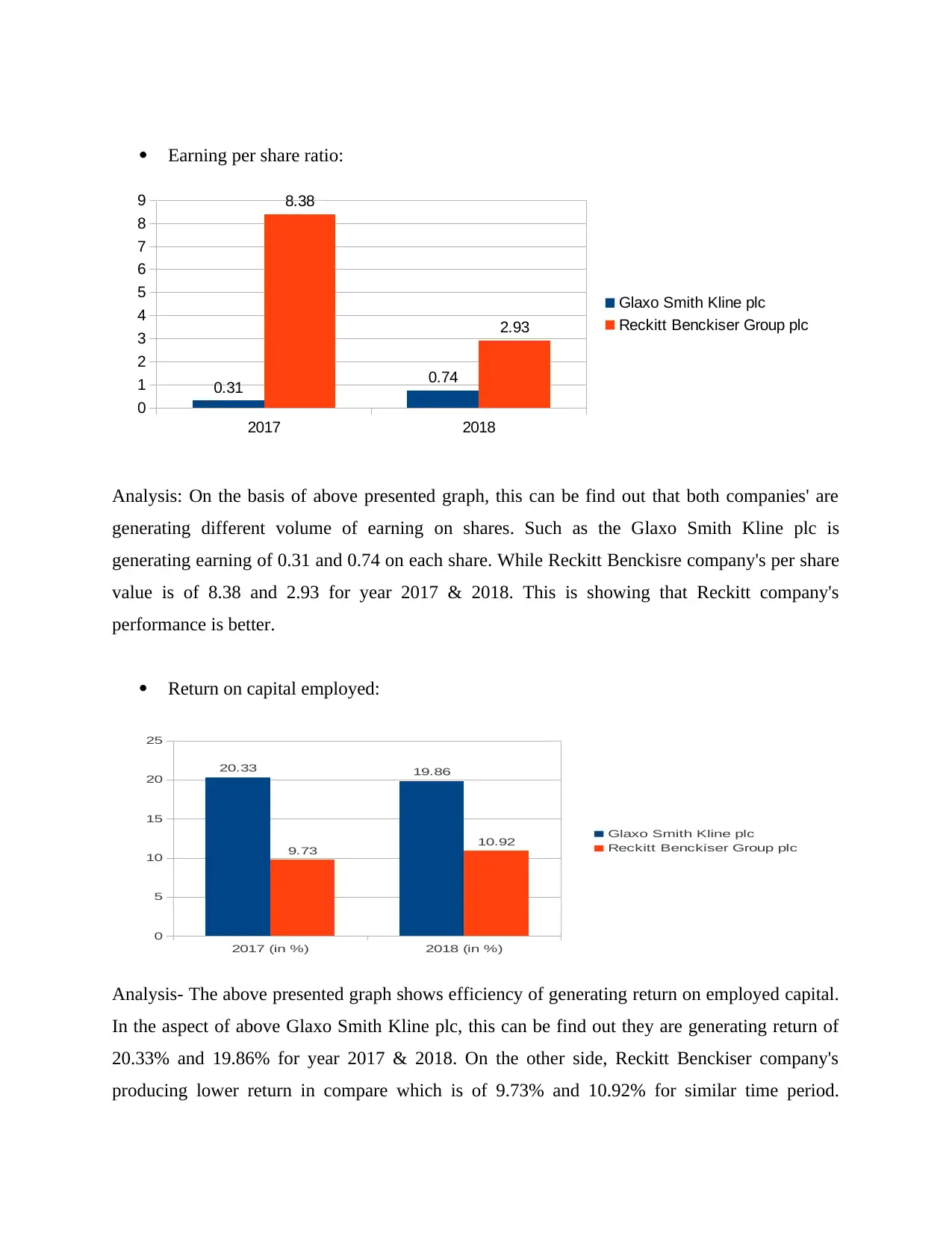
Earning per share ratio:
Analysis: On the basis of above presented graph, this can be find out that both companies' are
generating different volume of earning on shares. Such as the Glaxo Smith Kline plc is
generating earning of 0.31 and 0.74 on each share. While Reckitt Benckisre company's per share
value is of 8.38 and 2.93 for year 2017 & 2018. This is showing that Reckitt company's
performance is better.
Return on capital employed:
2017 (in %) 2018 (in %)
0
5
10
15
20
25
20.33 19.86
9.73 10.92 Glaxo Smith Kline plc
Reckitt Benckiser Group plc
Analysis- The above presented graph shows efficiency of generating return on employed capital.
In the aspect of above Glaxo Smith Kline plc, this can be find out they are generating return of
20.33% and 19.86% for year 2017 & 2018. On the other side, Reckitt Benckiser company's
producing lower return in compare which is of 9.73% and 10.92% for similar time period.
2017 2018
0
1
2
3
4
5
6
7
8
9
0.31 0.74
8.38
2.93
Glaxo Smith Kline plc
Reckitt Benckiser Group plc
Analysis: On the basis of above presented graph, this can be find out that both companies' are
generating different volume of earning on shares. Such as the Glaxo Smith Kline plc is
generating earning of 0.31 and 0.74 on each share. While Reckitt Benckisre company's per share
value is of 8.38 and 2.93 for year 2017 & 2018. This is showing that Reckitt company's
performance is better.
Return on capital employed:
2017 (in %) 2018 (in %)
0
5
10
15
20
25
20.33 19.86
9.73 10.92 Glaxo Smith Kline plc
Reckitt Benckiser Group plc
Analysis- The above presented graph shows efficiency of generating return on employed capital.
In the aspect of above Glaxo Smith Kline plc, this can be find out they are generating return of
20.33% and 19.86% for year 2017 & 2018. On the other side, Reckitt Benckiser company's
producing lower return in compare which is of 9.73% and 10.92% for similar time period.
2017 2018
0
1
2
3
4
5
6
7
8
9
0.31 0.74
8.38
2.93
Glaxo Smith Kline plc
Reckitt Benckiser Group plc
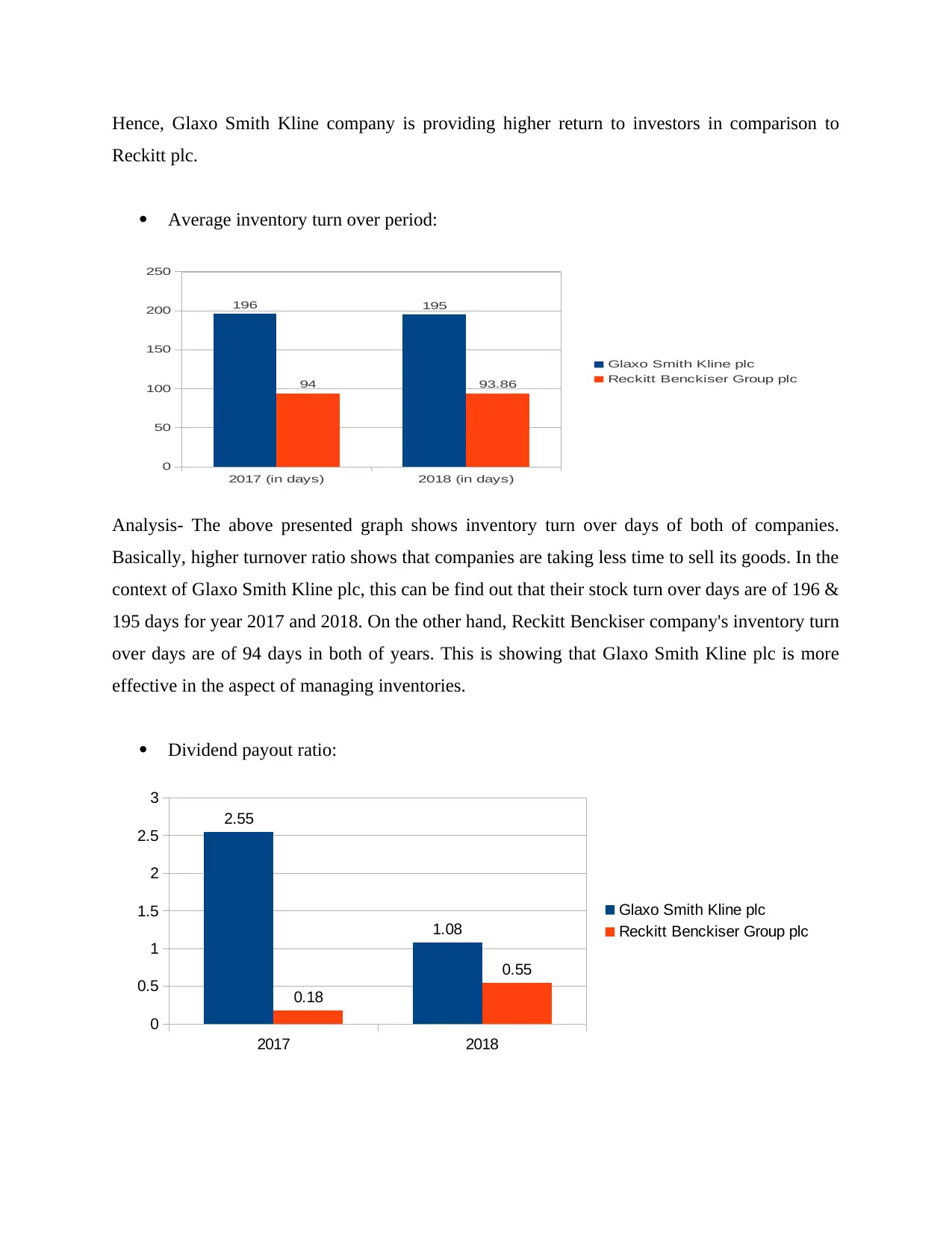
Hence, Glaxo Smith Kline company is providing higher return to investors in comparison to
Reckitt plc.
Average inventory turn over period:
2017 (in days) 2018 (in days)
0
50
100
150
200
250
196 195
94 93.86
Glaxo Smith Kline plc
Reckitt Benckiser Group plc
Analysis- The above presented graph shows inventory turn over days of both of companies.
Basically, higher turnover ratio shows that companies are taking less time to sell its goods. In the
context of Glaxo Smith Kline plc, this can be find out that their stock turn over days are of 196 &
195 days for year 2017 and 2018. On the other hand, Reckitt Benckiser company's inventory turn
over days are of 94 days in both of years. This is showing that Glaxo Smith Kline plc is more
effective in the aspect of managing inventories.
Dividend payout ratio:
2017 2018
0
0.5
1
1.5
2
2.5
3
2.55
1.08
0.18
0.55
Glaxo Smith Kline plc
Reckitt Benckiser Group plc
Reckitt plc.
Average inventory turn over period:
2017 (in days) 2018 (in days)
0
50
100
150
200
250
196 195
94 93.86
Glaxo Smith Kline plc
Reckitt Benckiser Group plc
Analysis- The above presented graph shows inventory turn over days of both of companies.
Basically, higher turnover ratio shows that companies are taking less time to sell its goods. In the
context of Glaxo Smith Kline plc, this can be find out that their stock turn over days are of 196 &
195 days for year 2017 and 2018. On the other hand, Reckitt Benckiser company's inventory turn
over days are of 94 days in both of years. This is showing that Glaxo Smith Kline plc is more
effective in the aspect of managing inventories.
Dividend payout ratio:
2017 2018
0
0.5
1
1.5
2
2.5
3
2.55
1.08
0.18
0.55
Glaxo Smith Kline plc
Reckitt Benckiser Group plc
⊘ This is a preview!⊘
Do you want full access?
Subscribe today to unlock all pages.

Trusted by 1+ million students worldwide
1 out of 22
Related Documents
Your All-in-One AI-Powered Toolkit for Academic Success.
+13062052269
info@desklib.com
Available 24*7 on WhatsApp / Email
![[object Object]](/_next/static/media/star-bottom.7253800d.svg)
Unlock your academic potential
Copyright © 2020–2025 A2Z Services. All Rights Reserved. Developed and managed by ZUCOL.





